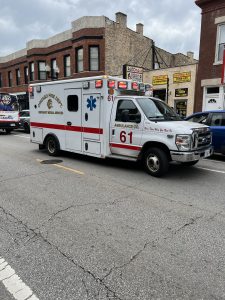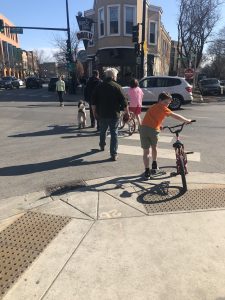On August 10, 2025, a Gage Park man was hit by an gray sedan as he attempted to cross the street in the crosswalk on South Kedzie Avenue at 3:20 am. The Chicago Suntimes reported that the gray sedan ran a red light, hit Jermaime Martin who was in the crosswalk and then sped away. The Chicago Suntimes reported that on August, 3 2025, a 31 year old man was struck and killed by a hit-and-run driver in Greater Grand Crossing. On July 22, 2025, The Chicago Suntimes reported that a pedestrian was struck by a maroon GMC SUV in the 500 block of North Pulaski Road. It seems there is a serious hit-and-run accident in Chicago every couple of days. The personal injury lawyers of Zneimer P.C. are currently handling multiple pedestrian and bike hit-and-run cases where clients have insurance. Unfortunately, victims of a hit-and- run that do not have auto insurance are out of luck since there is no one to collect from.
Chicago has a pedestrian safety crisis, and hit-and-runs are at the heart of it. Depending on which official dataset you check—and how late fatalities are reconciled—2024 saw at least 28 pedestrian deaths on city streets (plus five people on bikes), and possibly as many as 38 pedestrian deaths once CDOT’s later records were added. (chi.streetsblog.org)
Are police taking hit-and-runs seriously enough?
Victims’ families often feel abandoned—and a big reason is solvability. An NBC 5 investigation found CPD made arrests in only 0.3% of all hit-and-run crashes studied (three arrests per 1,000 crashes). That report is from 2022, but it illustrates the scale of the problem: without a plate, a witness, or video, cases can go cold fast. (NBC Chicago)
To CPD’s credit, tools and training are improving. The department and OEMC have expanded the use of automated license plate readers (ALPRs) and include ALPR orientation in training; Illinois State Police call ALPRs on expressways a “game changer.” Still, most neighborhood hit-and-runs happen off the interstates—where evidence can be scarcer and follow-up slower. (Chicago Police Department, Lake and McHenry County Scanner)
Bottom line: investigators work these cases, but clearance remains low. Chicago needs a “both-and” approach—better investigations and fewer opportunities for deadly crashes in the first place.
What the City can (and should) do now
1) Design safer streets, quickly.
Proven changes—curb extensions, daylighting corners, raised crosswalks, refuge islands, road diets, and leading pedestrian intervals—lower speeds and shorten crossing distances. These are core Vision Zero strategies the City has already endorsed; they need faster rollout on High-Crash Corridors identified by CDOT. (Chicago)
2) Get serious about safe speeds.
Speed is the single biggest factor in whether a person on foot lives or dies. Chicago debated lowering the default city speed limit to 25 mph; the proposal advanced but ultimately stalled in City Council this year. Re-introducing and passing a 25-mph default—paired with street redesigns—would save lives. (CBS News, WTTW News, chi.streetsblog.org)
3) Use automated enforcement where it’s proven to help—and do it equitably.
Chicago is adding new speed cameras near schools and parks this year under the City’s Children’s Safety Zone Program, with a warning period before ticketing. When they’re sited by crash data and paired with street fixes, cameras reduce dangerous speeding at those locations. (Block Club Chicago, Chicago)
(For the legally curious: the program is authorized by 625 ILCS 5/11-208.8 and implemented in the Municipal Code. (Illinois General Assembly, American Legal Publishing))
4) Invest in crash investigations.
Dedicated staffing, faster retrieval of nearby private video (businesses, residences, buses), and broader ALPR coverage on arterial streets—not just expressways—would increase identifications. The City already tracks and publishes crash data monthly; resourcing the follow-through is the next step. (Chicago)
What the law says (and why it matters)
- Leaving the scene of a crash with injury or death is a felony in Illinois. (625 ILCS 5/11-401). Stronger, consistent charging is part of deterrence—and critical for families seeking justice. (Illinois General Assembly)
- Drivers must stop and yield to pedestrians in crosswalks when signals aren’t present or operating. (625 ILCS 5/11-1002). Chicago also regulates pedestrian movement on through streets and crosswalk use in its Municipal Code. (Illinois General Assembly, American Legal Publishing)
What you can do after a hit-and-run
- Call 911 and get immediate medical help. Then, as soon as you’re able, report details to CPD’s Major Accident Investigation Unit; even partial plate digits or vehicle features matter. Recent CPD alerts often ask for tips tied to specific fatal crashes. (Chicago Police Department, CBS News)
- Preserve evidence: save clothing, take photos of injuries and the scene, identify cameras (doorbells, storefronts, bus stops) before footage overwrites.
- Check your own insurance: Illinois requires Uninsured Motorist (UM) coverage (minimum $25,000/$50,000) that applies to hit-and-runs; many people can recover through their own policy even if the driver is never found. Higher UM/UIM limits offer much better protection. (Illinois General Assembly, IDOI)
- Talk to a lawyer early: subpoenas for traffic, transit, and private video; FOIA requests; scene canvassing; and negotiating UM claims all move faster—and more successfully—when counsel is involved from the start.
Our view as plaintiff’s lawyers
Hit-and-run cases aren’t “no-one-to-sue” cases. We routinely pursue (1) claims against the at-fault driver once identified, (2) UM/UIM claims when they’re not, and (3) third-party claims where roadway design, lighting, or signal timing created foreseeable risks. We also push for safety changes—because every settlement after a fatal crosswalk crash is a reminder that prevention should have come first.
If you or a family member was hurt in a Chicago hit-and-run, the personal injury lawyers of Zneimer & Zneimer, P.C. are here to help—to investigate quickly, preserve critical evidence, and pursue every path to compensation. Call us for a free consultation.
Sources & references
- 2024 Chicago pedestrian/bike fatality tallies summarized from CPD/CDOT records and subsequent CDOT updates. (chi.streetsblog.org)
- City crash data, monthly fatality lists, and Vision Zero materials. (Chicago)
- NBC 5: very low hit-and-run arrest rate in investigation (illustrative of solvability challenge). (NBC Chicago)
- Speed policy debates and new cameras in 2025. (WTTW News, chi.streetsblog.org, Block Club Chicago)
- Children’s Safety Zone Program & legal authority. (Chicago, Illinois General Assembly, American Legal Publishing)
- Illinois statutes on leaving the scene and crosswalk right-of-way. (Illinois General Assembly)
- Illinois UM requirements and consumer guidance. (Illinois General Assembly, IDOI)
 Chicago Accident Lawyer Blog
Chicago Accident Lawyer Blog



